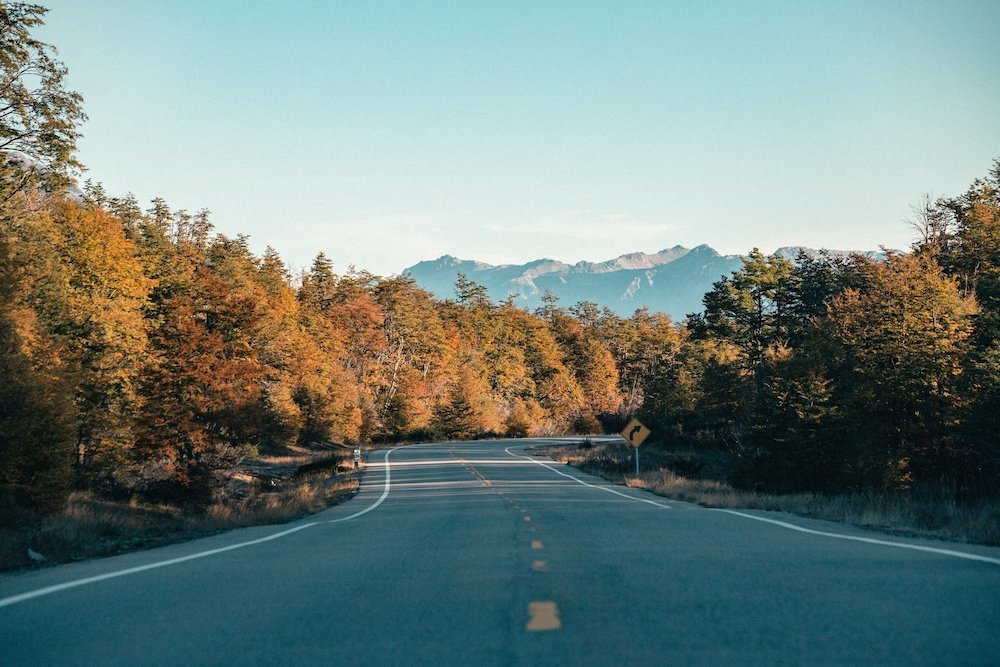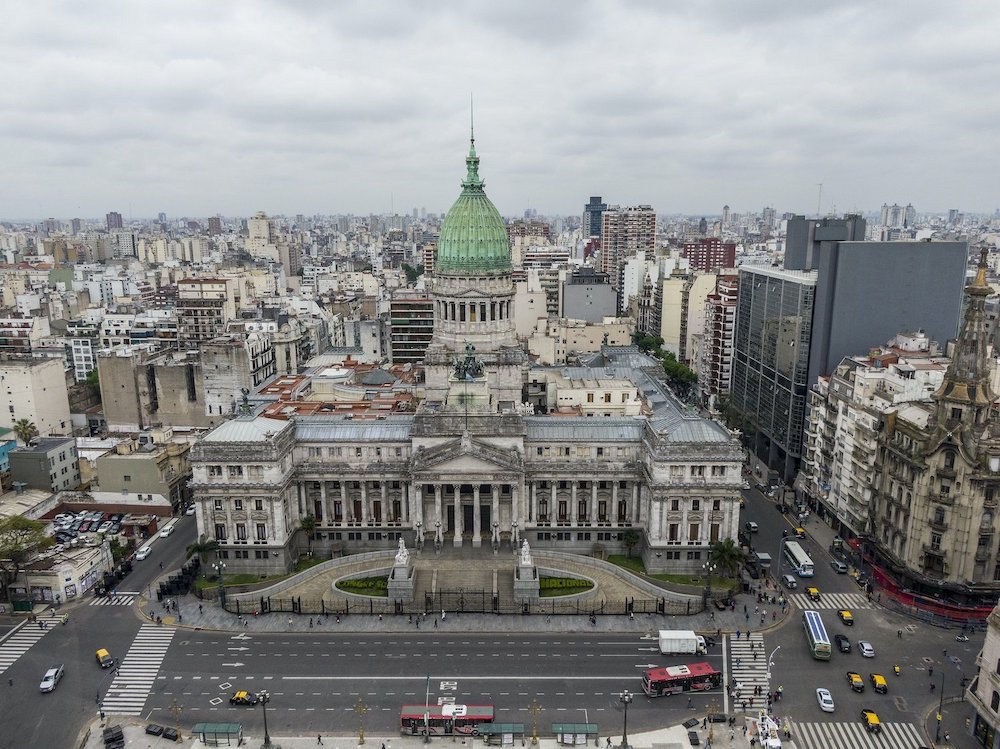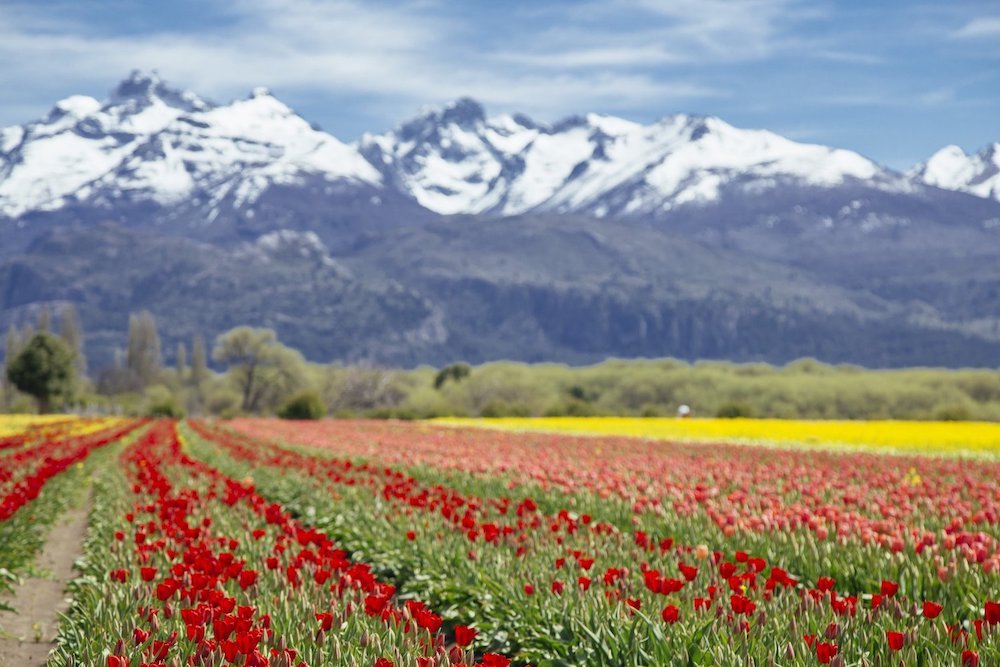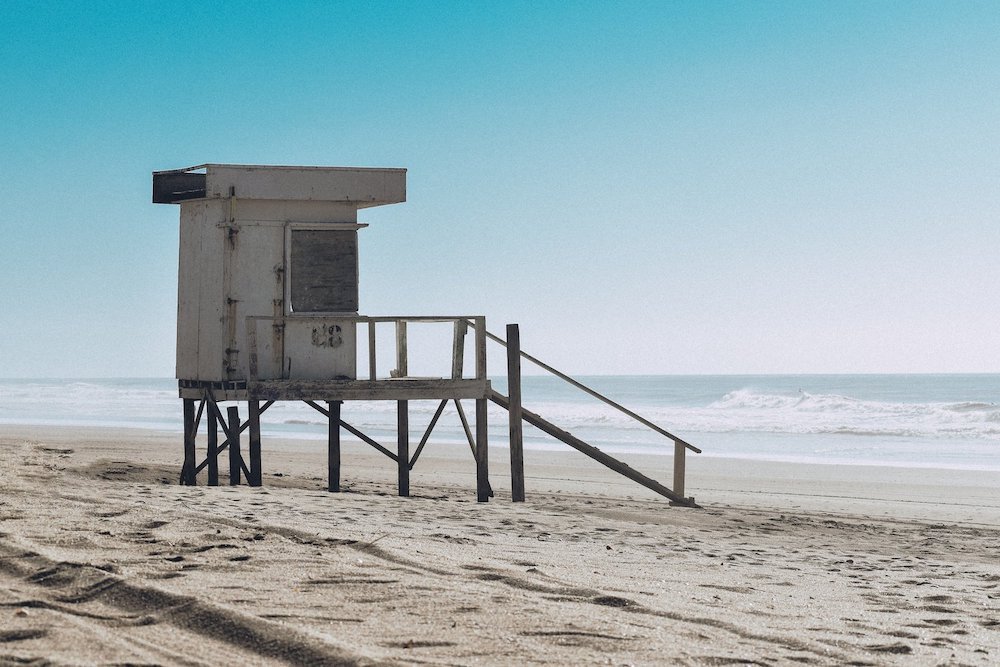When to Visit Argentina - A Guide to Every Season
If we had to recommend the best time to visit Argentina for the “average” traveler, we’d suggest coming here in mid-to-late spring, which is from October to early December.
In our opinion, spring is unquestionably the nicest time of year to explore Argentina.
Hotels and airfare are cheaper than at other times, the temperature is that “just right” middle ground between warm and hot, and most places are entirely devoid of tourists. The days start getting longer and sunnier, and the people are filled with life and excitement. Spring is simply a joyous time to be in Argentina.
With that said, there really is no single “best time to visit”, because the right time for you will depend entirely on where you’re planning to go and what activities you’re interested in.
This is a huge and diverse country, with widely varied geography and very distinct climatic regions. Even within the same season, the weather in different parts of the country will be completely different. For example, while Buenos Aires and Mendoza might be perfect to visit during the spring, but Patagonia might be cooler than you’d like.
Additionally, each season offers different activities, so depending on what you’re looking to do here, you should choose the season that’s best for those pursuits/interests. For outdoors-focused trips, the summer is perfect,, but the cities, especially in the north, could be sweltering. If you’re interested in skiing and winter sports, winter is the time for you, but just know that hiking and wildlife-watching will be pretty minimal.
In short, there’s no bad time of year to visit Argentina.
Read on for detailed advice on visiting in every season of the year!
More Argentina travel info:
If you could use some one-on-one help planning your itinerary, consider booking an Argentina travel consultation with Maria, our Local Expert!
Table of contents
Best time to visit
When is high season in Argentina?
Visiting Argentina in the Fall
Visiting Argentina in the Winter
Visiting Argentina in the Spring
Visiting Argentina in the Summer
Plan your itinerary with local help
If you could use some help figuring out a great plan for your trip, schedule an Argentina travel consultation with Maria, our Buenos Aires-based Local Expert!
These are one-hour Zoom calls where you’ll get to chat with Maria about the trip you’re planning and she’ll share her tips and advice, answer your travel questions, and help you perfect your itinerary.
Map of Argentina
To help you put things in perspective and understand how the various destinations and attractions that we discuss in this article are dispersed around Argentina, we’ve put together the map below. As you can see, Argentina is enormous and the places that you’re likely to be interested in visiting are spread all over the country.
Best time to visit Argentina
While the spring (September to December) is our favorite time of year to explore Argentina, there’s simply no bad time to come here and every season is potentially the “best” depending on your interests.
If cost is a consideration, one thing holds true throughout all of Argentina: there are two low seasons which run from March to June (fall) and September to December (spring). During these periods, prices will be lower across the country, you’ll find fewer crowds, and there will be much more availability for accommodation.
Now, let’s talk about Argentina’s size and widely varying climate, which is something you absolutely need to consider when deciding when to come here. This country is 900 miles wide and almost 2,400 miles long, so on any given day someone in Buenos Aires will be experiencing very different weather from someone in Salta, Mendoza, or Patagonia.
Think of it this way: the best time to visit Los Angeles is probably pretty different from the optimal season to be in New York. It’s the same in Argentina. So, when you should visit really depends on the region(s) you want to go to and what type of activities you’re interested in.
This is the 8th largest country in the world by landmass, and it’s also one of the most geographically diverse. Within our borders, you’ll find subtropical zones, the Antarctic, the tallest mountains in the Americas, endless beaches, rolling hills and virgin rivers, flatlands extending as far as the eye can see, long and lonely steppes, volcanoes, saline lakes, river deltas, wetlands, and tropical forest reserves. There’s a lot here and it’s spread out all across the country.
Below are a couple of examples that should hopefully give you a general idea of the wide-ranging possibilities and the different moving parts to consider as you begin planning your trip and deciding when to visit.
Patagonia/Southern Argentina - October to April
In my opinion, the best time to visit Patagonia is from October to April (our spring and summer), especially if you’re going there for the hiking. The trails will all be open, everywhere will be accessible, and the weather is mostly pleasant.
And while southern Argentina can have very nice weather in the summer, you can never be totally certain of what to expect. The weather here changes rapidly. We’ve been in parts of southern Patagonia in January and February (the height of summer) when there’s still snow on the ground.
While the winter scenery is beautiful in the southeast, it gets quite cold in much of Patagonia and heavy snowfall will often close roads and make travel impossible. Of course, if you like skiing and other winter sports, this is exactly when you would plan to come to Patagonia, but you need to be prepared to change your plans if routes become impassable.
Northern Patagonia - Spring or Summer
If you want to visit Bariloche, the lakes region, and other parts of northern Patagonia, and are interested in hiking, you should go there in spring or summer. Just be aware that Bariloche and Puerto Blest can see a lot of rain at this time of year.
Alternatively, if it’s skiing and winter sports that you’re after, then the winter is of course perfect.
Northwestern Argentina - March to November
If you want to enjoy the northwest, you’re generally better off coming from March to November (fall and winter), when the weather there will be mild. The Puna, a high plateau in the Andes on the border with Chile and Bolivia, is an exception to that however. High in the mountains (over 4,000 meters in some cases), places like La Quebrada de Humahuaca and San Antonio de los Cobres can get very cold in winter.
During the summer in the northwest, we have the rainy season and frequent storms can lead to overflowing rivers and closed roads. Not a great time to be here.
If all of this sounds overwhelming, it’s because it can be! This is a big country with many different climates, so you need to plan your trip well.
When trying to decide when to come here we recommend looking at it one of two ways: You can first decide where you want to visit and what you want to do in Argentina and then choose the season that’s most suitable for that. Or, just pick a date for your trip and then go wherever has the best weather at that time of year.
No matter when you end up visiting or where you go, you’ll never be short on things to do, so there are no bad options.
Keep reading below for expert local info on visiting in all four seasons.
When is high season in Argentina?
Argentina has two high seasons: winter and summer. While winter is a high season for local tourism (meaning Argentines), summer is definitely more popular with international tourists. Keep in mind, Argentina is in the southern hemisphere, so the seasons are reversed for anyone coming from North America or Europe. Summer runs from December to March, while Winter is from June to September.
The winter months are fairly mild in the warmer parts of the country (to the north), so a visit there in this period can be quite pleasant. You’ll have mild temperatures and much smaller crowds than in the summer.
But the star attraction during the winter in Argentina is unquestionably the skiing and winter sports/activities. Argentina receives thousands of skiers from all over the world during the winter months, who come here for great skiing in the Lakes District, around Mendoza, and in southern Patagonia.
If you visit in winter, you’ll also run into many traveling Argentines, as school vacation overlaps with this period and many families take advantage of the break to move about the country. As such, the winter tourist hotspots get quite busy and prices are high and availability for accommodation can be limited. You won’t see lots of other tourists if you travel outside of these areas though.
Summer, on the other hand, is always busy no matter where you go. Almost every corner of the country is popular in the summer months, especially for international tourism. Since our seasons are reversed from the Northern Hemisphere, many travelers come here to escape the cold and enjoy a second summer.
Perhaps the only exception to this rule is the far north of Argentina (such as Santiago del Estero) where the extreme summer temperatures are simply unbearable. Realistically, this isn’t a popular tourism region at any time of year anyways.
So, what should you expect in summer? Prices go up, airports are very busy, and the most popular areas are comparatively packed with people. We say “comparatively” because although Argentina is a popular destination, the crowds are still nowhere near like what you’d see in places like Prague, Rome, parts of Mexico, Egyptian hotspots, etc.
This may change, as tourism in the country is currently flourishing and Argentina is making its way onto many travelers’ “must-see” lists. In fact, Buenos Aires was the most visited city in Latin America in 2022.
If you decide to visit Argentina in the summer, be prepared for some crowds and definitely plan ahead and make your bookings in advance, but don’t worry about being crammed in shoulder to shoulder like sardines. That doesn’t happen here (not yet anyways).


Visiting Argentina in the Fall (March through May)
Although fall is shoulder season, it’s an excellent time to visit Argentina. Tourist numbers drop precipitously from the summer and with the exception of a couple of holidays (Easter and a few long weekends), even domestic travel is pretty limited. Prices are lower, there’s tons of availability, and it’s a quiet and relaxed time where you’ll get to experience the daily rhythms of Argentina and Argentine life.
In northern Argentina, the fall temperatures are more pleasant than in the summer months and there’s very little rain. There’s also gorgeous fall foliage, especially in the mountains, which show off their brilliant fall colors.
I especially recommend an autumn trip to Mendoza because the weather is perfect and the harvest season (La Fiesta de la Vendimia) has finished up, leading to an outflux of tourists. The mountain range, the vineyards, and the forests will all be displaying their beautiful and warm autumnal colors and the wineries will be starting production on next year’s wine.
Major cities in the mid-north regions, like Buenos Aires, Cordoba, Salta, and Mendoza, are also beautiful in the Fall. Temperatures are pleasant, the trees offer up a symphony of yellows, reds and oranges, and tourist numbers and prices are low.
In Buenos Aires, you also have the International Book Fair, which is a great event to check out. For culturally-focused travelers who are interested in urban Argentina, the fall is the perfect time for a city hopping trip.
For a great fall destination that’s off the beaten path, consider checking out Talampaya National Park in the province of La Rioja. The park houses ancient archaeological and paleontological sites, as well as spectacular and unique rock formations, a wide range of mammal ancestors, and traces of dinosaurs. Very challenging to visit in summer due to the stifling heat, the autumn is an ideal time to check out the park and surrounding province.
If Iguazú Falls is in your itinerary, this is again a great time to come, both for the moderate temperatures and the lack of crowds. The walkways all throughout are much emptier than at other times of the year, which allows you to enjoy the jungle in a far more intimate way. Of course, this is a world-famous destination and tourists come here all year, so we don’t want to give you the impression that you will have the place to yourelf. That never happens at Iguazú.
What about Patagonia? If you can, try to make it to Patagonia by the early fall. The first half of the season is a feast for the eyes, as the lengas and ñires trees of the region’s sub-Antarctic forests become brilliant shades of red, orange, yellow, and brown. These colors contrast strikingly with the turquoise waters of the lakes and glaciers.
The weather is also very pleasant at this time of year, with reasonably warm days and crisp evenings. Patagonia’s weather can never be taken for granted though, as snow in summer is not particularly rare and winter days warm enough for t-shirts happen fairly regularly.
Generally, snow arrives by mid-to-late fall (certainly by May) in Patagonia, so if you get here late in the season be aware that the variety of activities available to you will start to decrease. As with everywhere else in the country in the autumn, prices are fairly low, tourist numbers dip, and there’s not so much competition for accommodations, activities, etc.
Major fall holidays:
March 24th - National Day of Memory for Truth and Justice
April 2nd - Veteran's and Malvinas War Fallen Day
May 1st - Worker’s Day
Long weekends for Argentines:
Mid-April - Holy Week
May 25th - May Revolution Day
June 17th - Passage to the Immortality of General Güemes
June 20th - Passage to the Immortality of Gral Manuel Belgrano
Best places to visit in the fall:
Salta and Jujuy, Iguazu falls, Mendoza, Talampaya National Park in La Rioja, Valle de la Luna in San Juan, Los Glaciares National Park, Villa La Angostura, Ushuaia, and Buenos Aires .

Connect with our Argentina travel expert Maria for help perfecting your itinerary, answers to all your travel questions, and fabulous local tips for a better visit!
Visiting Argentina in winter (June through August)
Unlike many destinations in the world where winter is an undesirable time to visit, Argentina can be the perfect place for a winter holiday. As mentioned at the start of this article, Argentina is a huge and incredibly geographically diverse country, so you just need to make sure you choose the right places for your winter trip.
The winter months are quite busy for domestic tourism, as Argentines have their main winter holiday in June (one of the coldest months). Our holiday break typically lasts two weeks, but the touristic extends throughout the entire month because each province starts their holiday at a different time. Some take their break in the first two weeks of the month, others in the second and third, and others in the third and fourth.
This staged holiday period means that the crowds are controlled, to a degree, but the final two weeks of June are always the busiest because this is when the Buenos Aires schools go on break. Considering that 35% of Argentina’s population lives in or around Buenos Aires, this becomes an extremely busy period for local tourism.
Because the winter period is really only high season for domestic tourists (excluding a few ski destinations which also see lots of international tourists), the crowds will still not be anywhere like during the summer. For visitors, it can be quite fun traveling in winter because you’ll find yourself alongside vacationing locals rather than only other foreigners.
In Buenos Aires, there’s little to no tourism during the winter months. The weather isn’t perfect in the city at this time of year, it can get quite cold, and the days are fairly short. However, it’s often sunny and the air is much drier and purer when compared to the summer. The winter is a culturally rich period in Buenos Aires, with lots of activities and festivals to keep you entertained. The World Tango Festival takes place in August, so if you’re here in late winter, that’s a must-visit.
Generally, winter is also a good season to visit some of Argentina’s highlights, such as Iguazu Falls, Salta and Jujuy, as well as less-known places in the northeast like Chaco and El Bañado La Estrella in Formosa.
In the Corrientes province, you can see “Esteros del Iberá”, the second largest wetland in the world, only surpassed in size by the Pantanal (in Brazil, Bolivia, and Paraguay). For a unique cultural experience, the Pachamama celebrations take place in August, and that is an attraction on its own.
For lovers of the cold who are keen on snow and adventure, Patagonia is the obvious winter choice as it’s the perfect place for skiers. If you’re looking for a ski holiday, we’d recommend coming in August or September, as the ski lift lines are much shorter than during during the peak season in July.
For me, the best skiing is at Cerro Castor, which has light powdery snow on most days and the season runs all the way up to October. Less well-known, but an equally good winter destination is Las Leñas in Mendoza Province, which is lovely at this time of year and offers great trekking for hikers.
And my final tip: El Calafate receives practically no tourists in winter, which is a shame because it has quite a cold-weather charm, and when the snow covers the ice of the Perito Moreno glaciers, it’s a totally unique landscape.
Major holidays:
July 9th - Independence Day (note: the date often gets shifted around by a few days so that it can be combined with the weekend)
All of July - Winter holidays
Long weekends for Argentines:
August 17th - Paso a la Inmortalidad del Gral San Martín
Best places to visit in the winter:
Buenos Aires, Iguazu falls, Mendoza, Talampaya National Park and Valle de la Luna in San Juan, Esteros del Ibera. Cerro Castor, Chapelco and Las Leñas (for skiers)
Visiting Argentina in the Spring (September through November)
Spring is Argentina’s most romantic season. It’s a time of rebirth, of trees and flowers, but also of excitement and vibrancy. After months of hibernating, we Argentines emerge into the spring filled with energy and a desire to hit the road and begin exploring again.
While some places are thought to be fortunate for having perpetually spring-like weather, those of us who experience the changing seasons are the real lucky ones. We get to enjoy a rich diversity of climates, atmospheres, landscapes, and emotions all throughout the year. This is especially the case in Argentina, where we receive spring with open arms and burst into life.
In my opinion, spring is unquestionably the best time of year to explore Argentina. Hotels and airfare are cheaper, the temperature is that “just right” middle ground between warm and hot, and most places are entirely devoid of tourists. The days start getting longer and sunnier, and the people are filled with life and excitement. This is simply a joyous time to be in Argentina.
For beach lovers, you can escape to the Atlantic Coast towns of Pinamar, Villa Gesell, Cariló and Mar del Plata. It usually won’t be warm enough to swim until November or December, but if you got a few warm days, you’ll have the beaches all to yourself at this time. More interested in nature and landscapes than the beach? No problem!
Our four great springtime destinations of Salta, Puerto Iguazú, Mendoza, and San Carlos de Bariloche have stunning lakes and mountains waiting to be explored.
The entire province of Cordoba is a great springtime destination. The weather warms up very nicely and makes for perfect urban exploring and outdoor-focused trips. Cordoba was once the capital region during Spain’s colonial rule of Argentina, so the province is filled with picturesque colonial towns that are perfect to visit in the spring.
Add in the area’s nature beauty: rolling hills, clear and sandy rivers running through deep canyons, pristine hiking paths and camping areas, and wonderful natural springs and pools for swimming, and you have an unbeatable springtime combination. Perhaps the two most beautiful areas to visit are the Valle de Calamuchita and Traslasierra.
There are also many unique events and experiences going on all throughout Argentina in the spring, especially during the month of October. In Córdoba, you can head to Villa General Belgrano and celebrate our version of Oktoberfest.
In Trevelin, a small and hidden treasure in Patagonia, the tulip fields bloom with resplendent colors. Puerto Madryn, in northern Patagonia, is ideal for whale watching in this month (the whale-watching season runs from May to December, but October is the best month).
As spring heads toward summer, the weather warms up even more, and by November and early December you’ll often have great weather anywhere in the country. If you can make it to Argentina in the spring, you absolutely should. This is THE season to be here.
Major holidays:
September 11th - Teacher’s day (holiday for primary schools)
September 21st - Students day (holidays for high school)
November 20th - Día de la Soberanía Nacional (note: the date is sometimes moved around to line it up with the weekend)
December 8th - Día de la Inmaculada concepción de Maria (Dia de la Virgen)
Long weekends for Argentines:
October 12th - Día del Respeto a la Diversidad Cultural
October (flexible dates) – Oktoberfest in Vila General Belgrano, Córdoba
Best places to visit:
Buenos Aires, Iguazu falls, North Atlantic Coast, Salta/Jujuy, Calamuchita, Traslasierra Valley, Villa General Belgrano, Trevelin, Puerto Madryn.
Visiting Argentina in the Summer (December through February)
Summer is a great time to be in Argentina, especially the south of the country, as the weather can be lovely and everything is open and accessible (just remember, rain is not uncommon in northern Patagonia and the far south can still see snow, however).
The cities are bursting with events at this time of year and the natural areas are of course fantastic. Hiking, swimming, camping, and any other outdoor activity that you can think of are all possible. In northern Argentina, just be prepared for high temperatures and lots of humidity though. While Buenos Aires is Aires is bursting with life in the summer, it can feel pretty sweltering.
Expect plenty of crowds as well: this is the busiest time of year and both local and international tourists are traveling in large numbers all throughout the country. Prices for everything shoot up and you will need to book your accommodations and tours/activities well in advance. So, while there are a few things to be aware of when visiting Argentina in the summer, as long as you’re prepared and plan ahead, there’s no reason you shouldn’t have a fantastic trip.
While many destinations throughout the country are extremely popular from December through February, Patagonia is far and away the most visited area, especially for international tourists. This is with good reason: the weather in the summer months is usually quite pleasant, with warm but not hot temperatures, and everything is open and accessible. There are no road closures (unlike during the winter), all of the hiking trails are open, and this is the best time to see whales, penguins, sea lions, and elephant seals.
The possibilities in the summer are endless: explore crystalline lakes in the Andes; lounge on never-ending Atlantic coast beaches; take in extraordinary landscapes at the end of the world; and hike through pristine Alpine forests. Looking for even more action? Go kayaking, trekking, horseback riding, or rock climbing. Just about anything you can think to do outside, you can do in Patagonia in the summer.
You probably won’t have much solitude or get to experience nature in silence, but that’s the tradeoff for being here at the best (and busiest) time of year.
If you’re determined to find some solitude, you’ll have to go beyond the most famous destinations, but there are areas where you can definitely escape the crowds. In the province of Santa Cruz, places like Los Antiguos, Cueva de las Manos, Lago Posadas, Lago del Desierto, Puerto Deseado, San Julian, and the Petrified Forest are almost entirely off the standard tourists’ radars.
In Chubut, Bahia Bustamante is a wonderful place to visit, and the Gable Islands in Ushuaia are fantastic. These are only a few of the undisturbed destinations in Patagonia, and here you can connect with nature in silence and find a lonely corner to sit and contemplate.
Patagonia may be the major summer draw for international tourists, but for Argentines, the beaches of the Atlantic coast hold the greatest allure. From December through February, Porteños and city-dwellers from all over Argentina flock to the beaches to escape the heat.
If you’re interested in heading to the coast as well, you should know that Argentina is a not a classic beach-lovers paradise. The beaches are quite nice and we have many natural and wild ones unspoiled by development, but you wouldn’t come half way around the world just for them. In January in particular, the beaches can be unpleasantly crowded, and we don’t have gorgeous Brazilian or Caribbean-style sand and sea.
The water here is not crystal clear, the sand isn’t silky smooth and brilliantly white, and it can get quite windy, leading to rough seas (perfect for water sports and surfers, but not always ideal for casual beach lounging). Most of our beaches are sandy and shallow though, which makes them ideal for families with children.
As long as you come with the right expectations, a few days at the beach in summer is perfect. There are many great coastal areas to visit, but Mar del Plata, Pinamar, Cariló, and Villa Gesell are some of the more popular ones.
All the way west across the country, Mendoza and its surrounding winery region is a great summer destination. With long days of sunshine and fairly intense heat (hitting 100 degrees Fahrenheit is not uncommon), get ready for days of urban exploring, wine tours, and outdoor activities of all kinds.
Just make sure to have a hat and sunscreen for the daytime hours and bring a sweater for the evenings, when it cools down considerably. Evening rains are also common, but they’re usually very brief.
For visitors interested in our cities and culture, the summer months are full of activities and events. Buenos Aires will have lots of exhibitions going on and the theater season will be in full swing, with many performances all throughout the summer (except for at Teatro Colón, which closes for concerts and operas in January).
One little downside to coming here in the summer is that the soccer leagues take a break sometime between January and February (exactly when changes each year), so many summer visitors won’t be able to catch a game and experience one of the “musts” of Argentine popular culture. That shouldn’t be a dealbreaker, but it is too bad to miss out on that most Argentine of experiences.
Major holidays:
December 24-25 - Christmas
December 31st and January 1st - New Year holidays
Carnaval: It takes 4 days at some time of February, but has no fixed dates - they change every year!
Best places to visit:
North Atlantic Coast, Patagonia, Córdoba, Salta/Jujuy
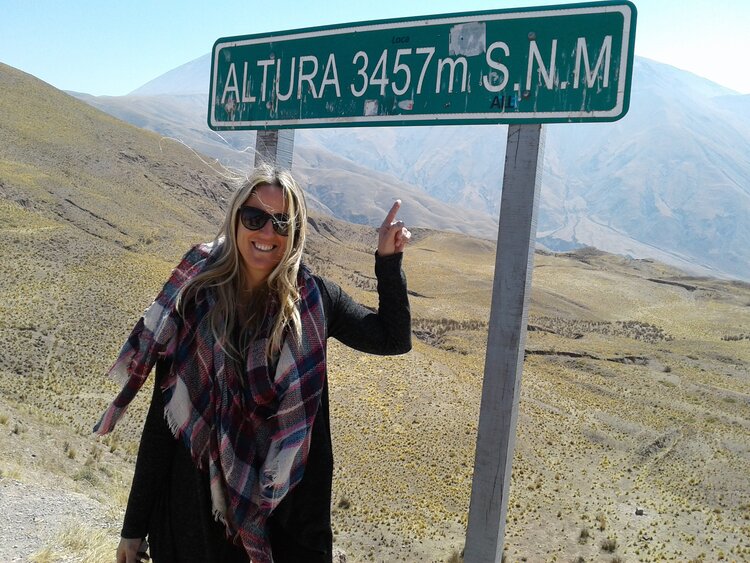


Connect with Maria










